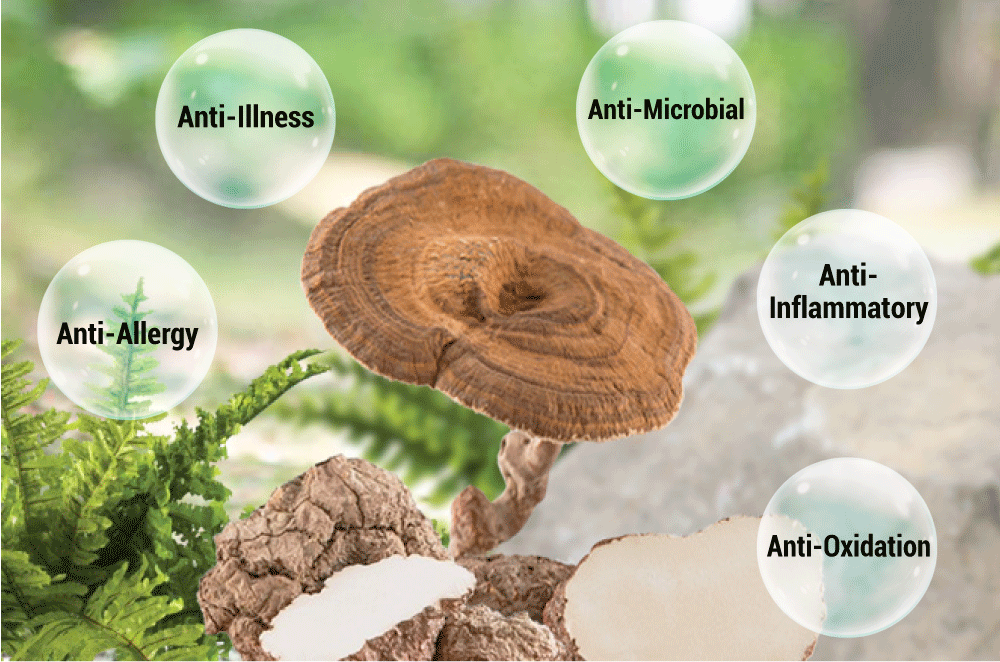
 Tiger Milk Mushroom : Malaysia's National Treasures
Tiger Milk Mushroom : Malaysia's National TreasuresIn 2002, the opening of the International Conventional on Biotechnology at Kuala Lumpur, the prime minister Tun Dr. Mahathir Mohamad shared his health secret about having a chronic cough stopped after he consumed Chinese traditional medicine derived from Tiger Milk Mushroom.
Tiger Milk Mushroom (Lignosus rhinocerus) is regarded as a medicinal mushroom with the ability to treat various ailments. In Malaysia, known as Cendawan Susu Harimau in Bahasa Malaysia and is entitled as Malaysia's national treasure. Tiger Milk Mushroom is a well known medicinal mushroom used by the local communities of Peninsular Malaysia to relieve fever, cough, asthma, cancer, food poisoning, and other lung diseases. According to folklore, the name comes from a story in which the milk produced by the tigress after giving birth to the tiger cub dripped on the soil, it absorbs the nutrients from air and soil then gradually forms sclerotia, so it is called Tiger Milk Mushroom. This fungus can be grown in a specific geographic region in tropical rainforests in the region of South China, Thailand, Malaysia, Indonesia, Philippines, and Papua New Guinea.
The Tiger Milk Mushroom was first founded in 1664 when a European government agent was given this product upon sailing to the South East Asian Region. According to The Diary of John Evelyn published on 22 June 1664, this mushroom named Lac Tygridis means "tiger's milk". In his publication, Evelyn also documented that this fungus was used by the local people to treat ailments for which European doctors found no cure.
In 1890, Sir Henry Nicholas Ridley, the father of Malaya's rubber industry, told that this fungus was a medicinal mushroom used by local communities. He even tried to cultivate it but failed. Then, Tiger Milk Mushroom was scientifically reported by Mordecai Cubitt Cooke who named it Fomes rhinocerotis based on a specimen found in Penang. Nowadays, it is known by the scientific name Lignosus rhinocerus.

Tiger Milk Mushroom consists of three parts: mushroom cap, stipe, and sclerotium. Unlike most other species of mushrooms, this fungus has a unique growth habit. Their growth is solitary and can find only one at a time. This species is sort of precious and rare due to the uniqueness of the solitary growth habit, and the distance between one fruit body and another is not less than 5 km. The underground fungus has sclerotia, where it will remain for a period of anywhere from a month to decades. The presence of sclerotium can only be seen when the mushroom sprouts.
Medicinal properties of Tiger Milk Mushrooms are only found underground, sort the tuber or sclerotium, but, once the formation of the mushroom's cap and the stem has happened, it's believed to cause depletion of most of its nutrients.
As a result of its unique growth habit, causing the inconsistent supply of raw material and uneven harvest quality, as well as lack of research, prevents further investigation and study on the health potential of the traditional health tonic.
In 2008, Dr. Tan Chon Seng, the father of Tiger Milk Mushroom, successfully discovered a solid fermentation technology to cultivate Tiger Milk Mushrooms in large scale.

The active compound that has medicinal benefits in the mushroom is beta-glucan, a naturally-occurring polysaccharide (complex carbohydrate). Sclerotium of the fungus consists of beta-glucan, specifically on the wall of the hyphae of mushroom, the branching tubes which make up the body or mycelium of a multicellular fungus. The mycelium is similar to the seed of a plant, the stock from which the mushroom grows. In-vitro tests have shown that beta-glucan plays a role in preventing the spread of cancer cells and improving the body's immune system.
Several kinds of research have completed examining its safety and bio-pharmacological efficacy to validate their ethnobotanical claims. Based on the studies, it has revealed that Tiger Milk Mushroom sclerotia to contain various biologically active substances, such as polysaccharides, polysaccharides-protein complexes, and β-glucan, which demonstrate anti-inflammatory, antioxidant, anti-proliferative, and immuno-modulating effects.
Traditionally, the Tiger Milk Mushrooms have been used for more than 400 years as a health tonic by the native for its healing properties on more than 15 types of medical ailments, including; treatment of lung and respiratory diseases including asthma, cough, fever, vomit, breast cancer, chronic hepatitis, gastric ulcer, food poisoning. It's also believed to help with wound healing and indigestion.

- Anti-Illness
Polysaccharide of sclerotia can stimulate the body to produce innate immune cells such as macrophages, natural killer cells and T lymphocytes, strengthening the body's defence against disease-like viruses. - Anti-Allergy
Has an anti-inflammatory effect, can effectively restore cellular metabolism, reduce the body's excessive reaction to allergens, help improve respiratory allergies (asthma, cough). - Anti-Inflammatory
Can effectively prevent the deterioration of inflammatory cells, repair damaged tissues and metabolic function of cells, improve lung and respiratory system function. - Anti-Microbial
Can activate immune cells in dormancy, improve body's ability to resist infection, effectively distinguish and eliminate viruses. - Anti-Oxidation
Studies have shown that sclerotia of tiger milk mushroom can prevent oxidative stress in the body.
Tiger Milk Mushrooms have been used for several hundred years, with no known toxicity or side effects. By OECD guidelines, various toxicity studies have been done, and prove that the mushroom is safe to take. Furthermore, it also undergoes a pre-clinical toxicological evaluation on the cultivated sclerotia of the Tiger Milk Mushroom. The conclusion shows that the treatment did not show any pathological changes in the liver, kidney, heart, spleen, and lung and also had no adverse effect on the fertility of the subject nor induce a teratogenic effect on their offspring.
 Organic Cordyceps
Organic Cordyceps Beta-Glucans
Beta-Glucans Aphanizomenon Flos-Aquae
Aphanizomenon Flos-Aquae Kiwi
Kiwi